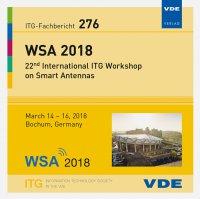Area Rate Evaluation based on Spatial Clustering of massive MIMO Channel Measurements
Konferenz: WSA 2018 - 22nd International ITG Workshop on Smart Antennas
14.03.2018 - 16.03.2018 in Bochum, Deutschland
Tagungsband: WSA 2018
Seiten: 6Sprache: EnglischTyp: PDF
Persönliche VDE-Mitglieder erhalten auf diesen Artikel 10% Rabatt
Autoren:
Arnold, Maximilian; Pfeiffer, Johannes; Brink, Stephan ten (Institute of Telecommunications, Pfaffenwaldring 47, University of Stuttgart, 70569 Stuttgart, Germany)
Inhalt:
Channel models for massive MIMO are typically based on matrices with complex Gaussian entries, extended by the Kronecker and Weichselberger model. One reason for observing a gap between modeled and actual channel behavior is the absence of spatial consistency in many such models, that is, spatial correlations over an area in the x; y-dimensions are not accounted for, making it difficult to study, e.g., area-throughput measures. In this paper, we propose an algorithm that can distinguish between regions of non-line-of-sight (NLoS) and lineof- sight (LoS) via a rank-metric criterion combined with a spiral search. With a k-means clustering algorithm a throughput per region (i.e., cluster) can be calculated, leading to what we refer to as “area-throughput”. For evaluating the proposed orthogonality clustering scheme we use a simple filtered MIMO channel model which is spatially consistent, with known degrees of freedom. Moreover, we employ actual (spatially consistent) area channel measurements based on spatial sampling using a spider antenna and show that the proposed algorithm can be used to estimate the degrees of freedom, and, subsequently, the number of users that maximizes the throughput per square meter.


